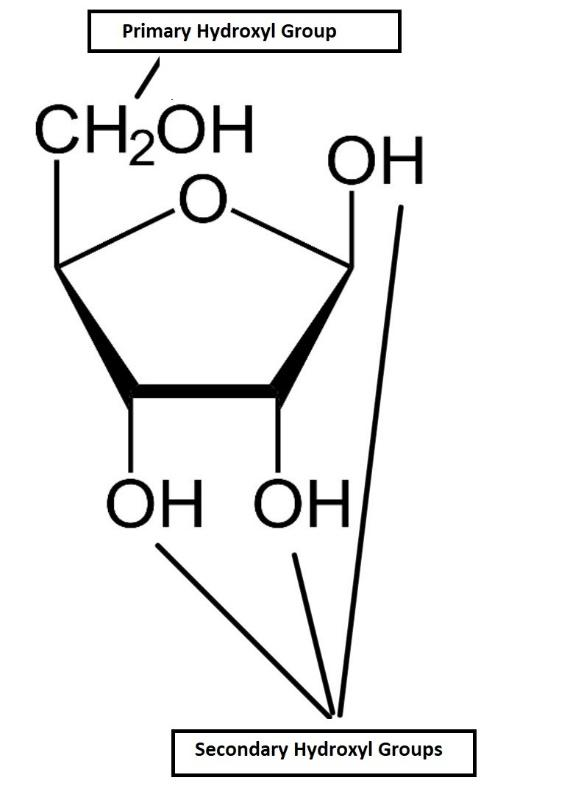
The number of primary and secondary hydroxyl groups in ribose are:
(A) 1,3
(B) 2,3
(C) 3,1
(D) 3,2
Answer
478.5k+ views
Hint: Ribose is an aldopentose or a monosaccharide containing five carbon atoms in its open chain form and it has an aldehyde functional group at one end. By identifying whether the hydroxyl groups are attached to a primary or secondary carbon atom we could out the number of primary and secondary hydroxyl groups in ribose.
Complete step by step solution:
- The knowledge of ribose is very important to identify the number of primary and secondary hydroxyl groups in ribose. It's a carbohydrate or a simple sugar molecule with the chemical formula ${ C }_{ 5 }{ H }_{ 10 }{ O }_{ 5 }$.
- The ribose is found in the genetic material RNA (ribonucleic acid). In RNA, the ribose sugar alternates with phosphate groups in order to form the backbone of RNA and then it binds with nitrogenous bases.
- We are asked to find out the number of primary and secondary hydroxyl groups in this molecule. As we know primary hydroxyl groups are attached to a primary carbon (only one other carbon atom is attached) whereas the secondary hydroxyl groups are attached to secondary carbon atoms (two carbon atoms are attached to the carbon).
- The structure of ribose is given below and from the structure we can identify the primary and secondary hydroxyl groups.

- As we can see the OH group in ${ C }{ H }_{ 2 }{ O }H$is attached to a primary carbon atom and hence it’s a primary hydroxyl group. The other three hydroxyl groups are attached with secondary carbon atoms and hence these are secondary hydroxyl groups.
Hence, we can conclude that there is one primary hydroxyl group and three secondary hydroxyl groups in ribose molecules.
Therefore, the answer is option is (A)1,3.
Note: In order to find out whether a hydroxyl group attached to a carbon atom is primary or secondary use the following method. First identify the OH group and locate the carbon to which hydroxyl group is bound to. Then count the number of carbon atoms attached directly to that carbon. If there is only one carbon then it’s a primary carbon and hence it’s a primary hydroxyl group. If two carbon atoms are attached, then it's secondary.
Complete step by step solution:
- The knowledge of ribose is very important to identify the number of primary and secondary hydroxyl groups in ribose. It's a carbohydrate or a simple sugar molecule with the chemical formula ${ C }_{ 5 }{ H }_{ 10 }{ O }_{ 5 }$.
- The ribose is found in the genetic material RNA (ribonucleic acid). In RNA, the ribose sugar alternates with phosphate groups in order to form the backbone of RNA and then it binds with nitrogenous bases.
- We are asked to find out the number of primary and secondary hydroxyl groups in this molecule. As we know primary hydroxyl groups are attached to a primary carbon (only one other carbon atom is attached) whereas the secondary hydroxyl groups are attached to secondary carbon atoms (two carbon atoms are attached to the carbon).
- The structure of ribose is given below and from the structure we can identify the primary and secondary hydroxyl groups.

- As we can see the OH group in ${ C }{ H }_{ 2 }{ O }H$is attached to a primary carbon atom and hence it’s a primary hydroxyl group. The other three hydroxyl groups are attached with secondary carbon atoms and hence these are secondary hydroxyl groups.
Hence, we can conclude that there is one primary hydroxyl group and three secondary hydroxyl groups in ribose molecules.
Therefore, the answer is option is (A)1,3.
Note: In order to find out whether a hydroxyl group attached to a carbon atom is primary or secondary use the following method. First identify the OH group and locate the carbon to which hydroxyl group is bound to. Then count the number of carbon atoms attached directly to that carbon. If there is only one carbon then it’s a primary carbon and hence it’s a primary hydroxyl group. If two carbon atoms are attached, then it's secondary.
Recently Updated Pages
Master Class 12 Economics: Engaging Questions & Answers for Success

Master Class 12 Maths: Engaging Questions & Answers for Success

Master Class 12 Biology: Engaging Questions & Answers for Success

Master Class 12 Physics: Engaging Questions & Answers for Success

Master Class 12 Business Studies: Engaging Questions & Answers for Success

Master Class 12 English: Engaging Questions & Answers for Success

Trending doubts
Which are the Top 10 Largest Countries of the World?

Differentiate between homogeneous and heterogeneous class 12 chemistry CBSE

What is a transformer Explain the principle construction class 12 physics CBSE

Who is Mukesh What is his dream Why does it look like class 12 english CBSE

Draw a labelled sketch of the human eye class 12 physics CBSE

What are the major means of transport Explain each class 12 social science CBSE




